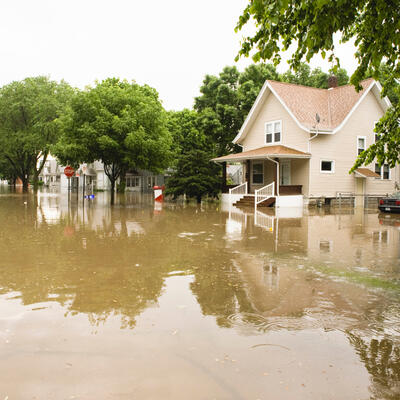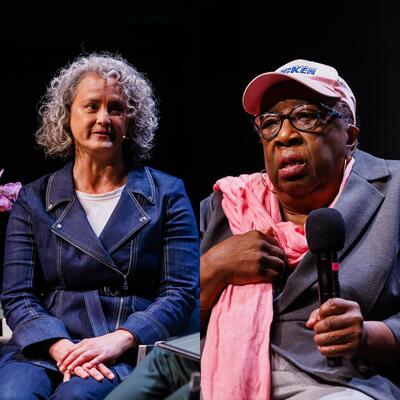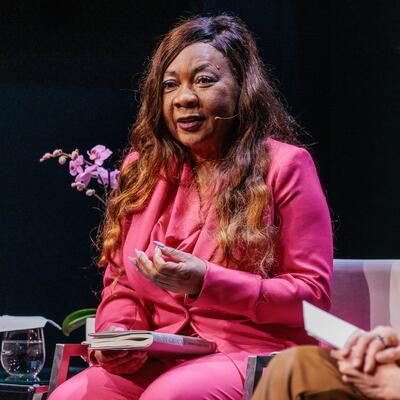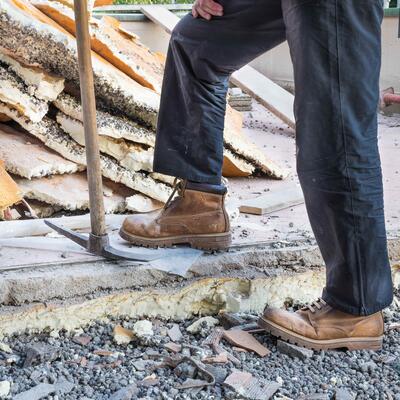
Colorado River Reckoning: Drought, Climate and Equal Access
Guests
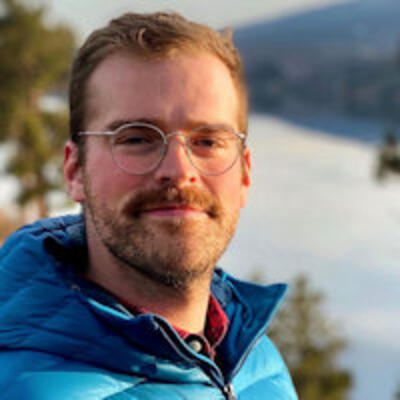
Luke Runyon

Bidtah Becker
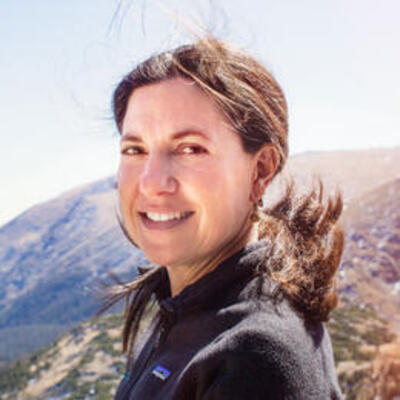
Jennifer Pitt
Summary
The Colorado River hydrates more than 40 million people and 5 million acres of farmland from Wyoming to the US-Mexico border -- but it's not equally divided. And as our climate gets hotter and drier, water managers worry there simply may no longer be enough to go around.
After another record-setting hot and dry year in 2020, the western U.S. is now in widespread extreme drought. The nation’s two largest reservoirs, Lake Powell and Lake Mead, are dropping to historic lows, putting water supply and the hydropower they generate at risk.
Lake Mead has fallen to the lowest level since it was filled in the 1930s after the construction of the Hoover Dam.
“It’s sending a message to the whole basin saying we don't have enough water to meet all of the needs that exist within the basin,” says Colorado journalist Luke Runyon.
This comes at a time when states and tribes are gearing up to begin the next round of negotiations on how to share the water — and ensure everyone has access.
Tribal water users, historically left out of those talks, are hoping to have a bigger say in those basin-wide negotiations, and to finally correct an historic injustice by ensuring universal access to clean water for tribes.
A 2019 report by the nonprofit Dig Deep found staggering rates of inequity in terms of access to clean water.
“If you were Native American, you were 19 times more likely to not have plumbing in your home, compared to white people,” says Navajo Tribal Utility Authority Associate Attorney Bidtah Becker.
“Climate change is not new; we’ve known about it since the 1970s, and we’ve seen the effects, and tribes are on the front line of it,” Becker says. “That cannot prevent the federal government to living up to the responsibility to getting clean drinking water to all homes in Indian country.”
As the climate crisis increases pressure on the limited water supply within the Colorado River Basin, water conservation will play a much bigger role, says Jennifer Pitt, Colorado River program director with the National Audubon Society.
“Until very recently, the entire exercise was focused on taking more water out of the river and putting it into use on the land. And I’m not saying there haven’t already been some robust investments in water conservation, but I am saying we’ve only begun to tap that potential,” Pitt says.
Water sharing agreements and other flexible policies can also help apportion this increasingly limited resource.
“I hope that as we confront declining water supply in the West, as we confront rivers drying, we as a society can have the foresight to realize that the choices that we’re making today are going to have significant consequences — not just for our own future, but for our children and their children and on and on,” Pitt says.
Related Links:
Water and Tribes Initiative
Universal Access to Clean Water for Tribes in the Colorado River Basin
Declining Lake Powell Levels Prompt Colorado River States To Form New Plan
Reconnecting the Colorado River to the Sea
Full Transcript
Greg Dalton: This is Climate One. I’m Greg Dalton. Water from the Colorado River, lifeblood of seven western states, is getting tighter as the climate warms.
Jennifer Pitt: There’s a big gap between how the system was built into place and perhaps where we want to go for our future.
Greg Dalton: Levels at the river’s largest reservoir are falling to historic lows.
Luke Runyon: It’s sending a message to the whole basin saying, we don’t have enough water to meet all the needs that exist within the basin.
Greg Dalton: This comes at a time when states and tribes are re-negotiating how to share the water--and ensure everyone has access.
Bidtah Becker: Climate change is not new, we’ve known about it since the 1970s and we’ve seen the effects, and tribes are on the front line of it. That cannot prevent the federal government to living up to the responsibility to getting clean drinking water to all homes in Indian country. A Colorado River Reckoning. Up next on Climate One.
Greg Dalton: The Colorado River hydrates more than 40 million people and 5 million acres of farmland from Wyoming to the US-Mexico border -- but it's not equally divided. And as our climate gets hotter and drier, water managers worry there simply may no longer be enough to go around. After another record-setting hot and dry year in 2020, most of the western U.S. is now in extreme drought. The nation’s two largest reservoirs, Lake Powell and Lake Mead, are dropping to historic lows, putting water supply and the hydropower the dams generate, at risk. Journalist Luke Runyon covers the Colorado River Basin for KUNC in Greeley, Colorado. I asked him for a quick refresher on how western states originally divided up the water from the river.
Luke Runyon: The Colorado River’s water was initially divided in 1922 and that's the Colorado River Compact. It was an agreement that was signed among the seven US states that rely on the river and that's made up of an upper watershed of Colorado, Wyoming, Utah and New Mexico and a lower watershed of California, Arizona and Nevada. And so, those states got together and they said, you know we need to figure out a way to divide the water of this river that we all share. And from there kind of build this legal scaffolding that has divided the water between those seven US states but also to states in Mexico you have relationships now with tribal entities. So, people refer to it as the law of the river. And basically, that means over the last 100 years we built this incredible legal foundation on which we decide how to share the Colorado River.
Greg Dalton: Very complicated. So, Lake Mead the biggest reservoir on the river is forecast to fall to the lowest level since it was filled in the 1930s after the construction of the Hoover Dam. How big a deal is that and what is it mean for people in the American Southwest and let's not forget those two states of Mexico?
Luke Runyon: It’s a really big deal because the Colorado River for much of it, you know, kind of that legal span from the time that the compact was signed until now, much of the discussion in the Colorado River Basin has been who gets the next drop, who puts in the newest straw who builds the new reservoir. The conversation very recently has shifted to who has to use less. And that discussion is very difficult. And we've built up massive cities, Los Angeles and Denver and Las Vegas all rely on the Colorado River. We've also built up agricultural areas that much of the country, much of the world is reliant on for fresh produce and beef. When you have that shortage declaration in Lake Mead it’s sending a message to the whole basin saying we don't have enough water to meet all of the needs that exist within the basin.
Greg Dalton: Right. And you mentioned that compact from 1922 some have suggested that that was constructed in a relatively wet period and now we’re reverting to a more historically normal or dry period. Some scientists even say we’re entering a new mega drought, is that the case?
Luke Runyon: Yeah, the Colorado River Compact when it was signed in 1922 was in a wet period. And kind of the original sin of the compact is that it put more water on paper than actually exists in the river. So, right from the get-go you have a river system that is over allocated. And then every agreement after that was kind of building on that same that same falsehood. And so, when you have that supply demand imbalance built into the river then even these large reservoirs aren’t gonna be able to keep up and that's really what we’re seeing now is that you know the rights that people have to water on paper it’s a promise. They expect that water to be delivered to them and these large reservoirs just cannot keep up with the demand that we have on paper. The water just doesn't exist.
Greg Dalton: The current water sharing agreement in the Colorado River Basin ends in 2026 and the seven states are gearing up for the next round of negotiations with how to decide to allocate that water. What are the key sticking points and who's holding the power?
Luke Runyon: So, those seven US states are all kind of beginning to posture and put out their priorities for those discussions. And it might be easiest if we divide that into what the upper basin is thinking about and what the lower basin is thinking about. So, the upper basin states they've actually been below their allocation in the Colorado River Compact. They haven't used what they have on paper. And so, you hear a lot about projects in the upper basin. There's one in southern Utah called the Lake Powell Pipeline that’s gotten a lot of press. And those states say it's not our fault that we developed slower. We still have our allocation on paper that we would like to develop into. And just because the lower basin is having problems doesn't mean that that should slow us down.
Greg Dalton: So, you’ve been hogging water we still have ours we’re still entitled to ours, okay.
Luke Runyon: Yeah, we should be balancing out the uses in the two basins. The lower basin the discussion is much different. There, it’s all about how do we rein in our uses because the crisis is hitting the lower basin much sooner than it's hitting the upper basin. With Lake Mead and Lake Powell both approaching historically low levels I think people see the writing on the wall that you can't keep relying on these reservoirs to deliver the amount of water that they have in the past. And already Nevada, Arizona, and the country of Mexico have taken cuts to their allocation from the Colorado River and I think we’re gonna see more pressure on California to start taking more cutbacks from the Colorado River as well. So, that's really the discussion there is who has to use less and under what conditions. And that's a really hard discussion to have.
Greg Dalton: Really hard and in the past tribes have been excluded climate change has been excluded. You know, are tribes and climate change being included this time around?
Luke Runyon: There's definitely a move toward including tribes in the discussions. And I think that that's happening on a few different fronts. I think you've heard more from state leaders that it's really important to have tribes at the negotiation table. You've heard it from the Biden administration which will play a role in these negotiations as well. And part of it is from a social justice perspective, it just makes sense to have tribes they have rights to the river just like everyone else and they need to be included in the conversation. And, you know, tribes have some of the most senior water rights in the Colorado River Basin and a large portion of the rivers flow is included in those rights about 20% of the Colorado River's total flow is held in rights by the 29 tribes that are in the watershed. They haven't had the means or the ability to use all of those rights, but they exist on paper. And so, trying to figure out who invests in kind of tribal water infrastructure. What are the mechanisms that need to be put in place in order to bring tribes to the negotiating table? Those are kind of being figured out right now and that's definitely a hot topic in the basin.
Greg Dalton: Luke Runyon is a reporter with KUNC in Greeley, Colorado, who covers the Colorado River Basin. Well, talk about conservation. Is it possible to convert lawns to drought-resistant drought-tolerant landscaping, shorter shower all these sorts of things. Have we already squeezed all of that out or there’s still more conservation that can have a meaningful impact?
Luke Runyon: Yeah, large cities are starting to look at outdoor water use as a way to kind of live within their means. You're seeing this play out this year in particular in Las Vegas. The Nevada Legislature is most likely gonna pass a bill that would make it illegal to have what they call nonfunctional turf. And this is grass that only gets walked on when it's being mowed. That's kind of the way that they've defined it. So, you think of medians with grass on them in streets or business parks with large grassy front facades.
Greg Dalton: Ornamental lawns.
Luke Runyon: Yeah. And, you know, Las Vegas for a while has had a significant incentive program where you get paid to take out your lawn. And I think that they've realized that that's not enough, at a certain point you incentivized all of the turf removal that you can and you have to go more towards this legislative route. But, yeah, there's a lot of areas within the Colorado River Basin where we can reign in our use, it’s just, we have to as a society get used to the fact that there is not enough water to have all of the nice things that we want. And that takes a little bit of persuasion and convincing and it maybe isn't the most convenient political argument for some, but I think in some large cities, especially in the lower basin, you’re gonna see a lot more calls for conservation.
Greg Dalton: Scientists say that the wets get wetter and the dries get drier due to climate change. And we’re seeing that concentration of water in certain places and then other places is getting drier. So, we’re talking about a really conservative part of America from Wyoming to Nevada to Arizona, lot of ranching, outdoors. How is climate change playing in this conversation?
Luke Runyon: I think more and more you’re hearing a lot more people who agree that something is off. Now, whether you call that climate change, whether you call that global warming you know maybe the semantics can shift. But I think it's impossible to ignore the kind of on the ground changes that are taking place. Even if you are a rancher who leans more conservative you know I talk to those people all the time and they would say, you know, I've never seen it like this. It's so dry, it's, you know, I've never seen my reservoir that's just upstream go almost completely dry. So, when it's affecting your livelihood, I feel like you can't ignore the changes that are taking place. It's just maybe how you frame it in your mind is where the changes, you know, not everyone calls it climate change. Some people call it global warming or drought or, you know, forever drought mega drought. It just depends on the word that you're using.
Greg Dalton: Science has said the West is an emerging mega drought that is bad or worse as the droughts of the past 1200 years. I'm having a hard time getting my head around that. What does that mean, a mega drought, lasting supposed to last several decades or longer.
Luke Runyon: Yeah, and we've seen evidence of mega droughts in tree ring studies in the American Southwest. And we know going back and looking at those tree rings that things can get really, really dry in the Colorado River Basin. And over the last 2021 years we've been in an extended dry period with increasingly warming temperatures in the basin. And I think when people use the word drought it indicates sort of a temporary nature that you go through a year-long or two-year long drought. And when a drought lasts for 20 years, that word doesn't feel like it captures what's actually happening on the ground. And mega drought maybe is more of a way to think about this as not just a temporary state, but a fundamental change in precipitation and temperature in a region. And, you know, I don't have a crystal ball so I have no idea when we’re supposed to pull out of this, but for right now all the climate science is showing that the basin will continue to warm and that's gonna have significant impacts on our water supplies.
Greg Dalton: So, are we headed for a Mad Max water future? Are you optimistic or I know you don’t have a crystal ball but what your gut tell you about Mad Max future or something very different more positive?
Luke Runyon: I don't think we’re headed towards the Mad Max style water wars that you know people think about in the American Southwest. But there will be changes in how we live in cities and how agriculture functions in the basin. And that's really, you know, you talk to some people who say you know there's always going to be water for people in the Colorado River Basin. Will there always be water for people and hay to be grown and some of these other crops to be grown? Maybe not. Agriculture might have to shrink a bit in the basin in order to meet everyone's water needs. And you know conservation has to kind of take place across the board in order for us to match the declining supply. It’s gonna be a hard discussion and it’s gonna have to take place across many states. But I think that we can do it I think that we have to do it. There's no other way out of it.
Greg Dalton: Luke Runyon, thanks for sharing your story here and your ideas on Climate One.
Luke Runyon: Thanks so much for having me. I had a great time.
Greg Dalton: You’re listening to a Climate One conversation about climate impacts and access to the Colorado River water supply. If you missed a previous episode, or want to hear more Climate One empowering conversations, subscribe to our podcast wherever you get your pods. Coming up, tribes see an opportunity to correct a historic injustice -- a lack of access to clean water -- in future Colorado River negotiations.
Bidtah Becker: If you were Native American, you were 19 times more likely to NOT have plumbing in your home, compared to white people.
Greg Dalton: That’s up next, when Climate One continues.
Greg Dalton: This is Climate One. I’m Greg Dalton, and we’re talking about climate risks and water sharing on the Colorado River. Bidtah Becker is an attorney with the Navajo Tribal Utility Authority and co-lead on the Universal Access to Clean Water Initiative. Climate One’s Ariana Brocious spoke with Becker about that effort, which is part of the larger Water & Tribes Initiative started in 2017, which Becker says is aimed at lifting up the voices of the 29 tribes in the Colorado River Basin.
Bidtah Becker: And specifically, they started the initiative to raise their voices in preparation for something called the renegotiation of the 2007 interim guidelines. And they’re very high level, those are guidelines that address the management of the Colorado River.
Ariana Brocious: Right. And tribes have sort of historically been excluded from these negotiations around water sharing in the Colorado River Basin even though on paper tribes hold about 20% of that water. So, with the Water & Tribes Initiative do you see that changing this time around?
Bidtah Becker: Yes, it’s estimated that tribes have a minimum of about 20% of the rights in the basin, but there's still some tribes who would need to do what’s called quantify their rights. But the question is, why do the tribes feel like they haven't been heard? So, the way the Colorado system works is that at some point, the courts ruled that the tribal allocation needs to come out of the state’s allocation. So, there are seven states in the basin they allocated the water amongst themselves. But even when they were allocating the water in the 1920s there is a recognition and there is a statement in the Colorado River Compact that recognizes that the United States has what's called the trust responsibility towards the water rights of the tribes. So, fast-forward I've mentioned three sovereigns, the United States, the states, and then the tribes. There's 30 of them, each with a totally different flavor, situation, where you're located on the river, what you put your water to use for. These are all different factors that I think go into this question of why haven't tribes been heard. But what's most exciting for me as we seem to be entering into a new policy era of equity, social equity, racial equity, economic equity. And I'm pretty hopeful that this will be a very defining moment in this country's history, especially when it comes to native people in recognizing native peoples human right to water, but also in native people's ability to continue to exist despite all odds against that, right.
Ariana Brocious: As we know the pandemic showcased a lot of these structural inequities. And one of them as you obviously well know, is the lack of running water access for some tribes, for some tribal people, and especially during the pandemic at a time when literally handwashing was of life-saving importance. And so, I think a lot of Americans might be surprised to know that there are still households in this country today that don't have running water or universal access to clean water. And so, you are part of a recent report highlighting the need for this among tribes and what are sort of the key takeaways to lift up from that report?
Bidtah Becker: I would say the first key takeaway is that water is life. I think it's something not only do most people in this country take for granted that you turn a tap and clean drinking water mysteriously comes out of it but also how water is integral to every single aspect of our lives. I think we sometimes forget that. but it's whether it's washing your car, washing your floor, you know, giving the baby a bath, to cooking, to as you mentioned handwashing during the pandemic. But all of that that I mentioned is also referred to as sanitation. So, when a home either lacks piped water or is even using something called a cistern system where there might be piped water put into a tank and that's pumped through the home. Those are not the standards of sanitary that this country expects. But back to the report, the second is a take away that actually builds off of that comes from an earlier report, a 2019 report issued by the US Water Alliance. And it was developed in conjunction with the nonprofit called DigDeep. And DigDeep and US Water Alliance determined that if you were Native American you were 19 times more likely to not have plumbing in your home compared to white people. I think what's more striking about that statistic is it’s truly a Native American problem because they found that Black and Latinx households are two times less likely to have plumbing in their homes than white people. So, it's this dramatic jump, right. And I do think that that's a reflection of some historical inequities. Then the third big takeaway is that there are four different types of water insecurity. One is water quality issues. Another bucket is what we call deteriorating or inadequate water infrastructure. And at this point I will say these issues quickly become non-sexy and sort of boring, right.
Ariana Brocious: And structural, right? Really like I mean you're talking plumbing, piping that takes a lot of money and work. So, I'm curious, with these barriers. Frankly, whose responsibility is it to ensure that tribes have clean and adequate access to water?
Bidtah Becker: Sure. As the report lays out and for your listeners the report can be found online. It’s very clearly the federal government's responsibility. So, when the federal government was moving tribal people or entering into treaties with tribal people or identifying land base for tribal people, it's very clear that what came along with the responsibility for identifying land is also ensuring that there is a water supply for tribal people to have access to because again, the theory was that these homelands were meant to be permanent homelands forever and ever. I would like to think and I do believe that today in 2021 we would say, and I think the United States would agree there are places where tribal people are meant to thrive, right. And again, I would say that may be a developing thought in the historical record, but I do think the response to COVID has definitely been oh my gosh, yes, you should be able to have clean drinking water in your homes on your ancestral homelands where you’ve always lived. And you are right that it's very structural. I think that lack of infrastructure or the -- not just a lack but the infrastructure issues in this country are not well known, but have become well-known because of the debates going on in Congress and the Biden administration’s push for infrastructure development. Yeah, we tend to think you put a pipe in the ground and you can walk away from it, but that's not how infrastructure works. It needs to be maintained, which is the fourth bucket that we found which is that operating and maintaining these systems can be a structural challenge for tribes.
Ariana Brocious: You touched on the issue of water quality apart from quantity and can you discuss some of the legacy of environmental injustice here, particularly as it relates possibly to like the Hopi and arsenic contamination?
Bidtah Becker: Yeah, definitely. And I was part of a listening session with the White House, the Biden administration. And the Hopi tribal chairman was saying you know you, you, meaning the United States built our clean drinking water system into an aquifer that has arsenic and that was built in the 1960s. They estimate that today, approximately 75% of the people living on Hopi are drinking contaminated water. And now the US EPA, another arm in the government, wants to fine us at a level that could bankrupt the tribe, right. So, this is an issue of not only having inadequate water quality, but then not having the funding to address the EPA fines, but I think probably most of us would say well, shouldn’t we be focusing on getting them a clean drinking water system rather than fining them for something that was put in by the United States. In the 1950s the United States Congress created the Indian Health Service specifically to address Indian health and also to address the sanitation deficiencies in Indian country. But what’s very interesting is Congress has never funded that responsibility. So, Ariana, when you say like whose responsibility is it and we say the federal government, that’s when we quickly get into what you mentioned, the complicated nature of it.
Ariana Brocious: Right. And where does the funding ultimately come from, and you mentioned that you're feeling really hopeful that this is sort of a moment, possibly of transformation. And I'm wondering, you are working with the White House on this issue of universal access to clean water. So, what has that process been like? Have you found support? What's the reason for being hopeful?
Bidtah Becker: Definitely have found support. I think the fact that Pres. Biden is using the term systemic racism. You know, that’s groundbreaking in my world, you know, that's not something I would ever have thought I would've heard in my career. And I'm a lawyer by training so lawyers are very conservative. But real specifically, we’ve been working with the Domestic Policy Council and we’ve held two listening sessions. One specifically on critical infrastructure need and water. And then the second on the critical infrastructure needs in Indian country. And there it was three areas covered: water, broadband and roads. And that's what's so exciting about right now. The discussion of the amount of money that Congress and the White House are willing to put into critical infrastructure needs. That's a game changer.
Ariana Brocious: I'm talking with Bidtah Becker, an attorney for the Navajo Tribal Utility Authority and co-lead on universal access to clean water initiative. This idea you mentioned of the treaty responsibilities with the federal government in creating permanent homelands when climate change inevitably changes the availability of water to what extent do you think the government should be held responsible for that as well?
Bidtah Becker: Well, first of all, all human beings, and all American citizens have a right to clean drinking water. So, the issues that climate change, or is bringing drought or the, you know, mega monsoons and the mega drought, those are not issues that should prevent every American citizen of getting clean drinking water. And I don't say that lightly. Indian country is on the front line of climate change. The western part of the Navajo Nation has been facing sand dunes, just areas drying up and sand dunes taking over people's homes for 15, 20 years now, maybe longer. We have individuals on the Navajo Nation who had to buy their own tractors and backhoes in order to push that sand so that they can still get to their house. So, climate change is not new we've known about since the 1970s. We’ve seen the effects and tribes are on the front line of it. That cannot prevent the federal government to living up to the responsibility of getting clean drinking water to all homes in Indian country. And I do want to also add in Alaska native-communities they’re part of the same responsibility. One other quick story on how the Navajo Nation is on the front line of climate change in the 60s, there were two large coal-fired power plants constructed on the Navajo Nation and they were constructed to deliver all of their electrons off with the Navajo Nation. Navajo people, no Navajo entity on the nation enjoyed the electricity that was being produced. You know, in my lifetime the policy was still well, ‘let's use native resources to help non-Indian mainstream communities develop.’ And it wasn’t just Navajo, it was Hopi and Navajo coal was used for what's called Navajo Generating Station. And that was the largest coal-fired power plant west of the Mississippi, providing electrons to Las Vegas, Phoenix, Los Angeles, but in addition to using Hopi and Navajo coal it was the Hopi and Navajo workers about I think the numbers are like, 90, 95%, a thousand jobs and it was also water coming out of the Colorado River system that is Navajo water was also being used to produce this. So the end of the story is that Navajo Generating Station shut down in 2019 much of the surprise of many people, meaning coal had been the cheapest resource to use and until natural gas prices started falling in about 2016, 2017 nobody expected coal to go away. And the Navajo Nation definitely did not expect coal to go away they had expected the plant to stay open through 2044. So, it was a big shock to the system.
Ariana Brocious: Yeah, and the closure of that station as you are saying is a huge shift, not just for the power generation obviously the tribes there that depended on those jobs and the economy there in the region and there’s a lot to be discussed still and figured out about that transition. We had a show on that last fall. I wanted to just pivot back to where we started with this discussion about the negotiations coming up on the Colorado River and wondering how this access to clean water piece fits in with those discussions, and whether that can be something that tribes bring forward and say needs to be front and center as some of these questions of water sharing are worked out.
Bidtah Becker: Sure. I am not speaking for the tribes at all at this point. They need to determine what they want to bring to the table. Speaking personally, it seems to me we cannot solve the big picture of Colorado River water management without solving the small picture that as we’ve discussed, the United States has a responsibility to getting clean drinking water to tribal citizens. And so, as it's entering the negotiations it seems to me not just tribes should be thinking about this, but so should the United States and so should the states because tribal people are citizens of both states and the United States. Because everything we talked about as being complicated, they're all human made rules right. So, humans can go back and revisit their rules and look for bias and prejudice in them and figure out how to make an equitable society.
Ariana Brocious: There's been a lot of attention in the last year on social justice in this ongoing racial reckoning in the country, particularly around the Black Lives Matter movement. And I recall from talking with you that that's influenced your work and the work of this initiative. Can you describe that, how it's affected your work?
Bidtah Becker: So, when COVID broke out there was a, the Navajo Nation in particular, but there were other tribes and Alaska native villages who are suffering from lack of access to water and they were hit hard by COVID-19 rates. And people started to read about it people who I would argue should have known about the problem didn't know about it or were not perhaps aware of it or whatever, they became aware of the issues in the Colorado River Basin. And then at the same time you have this, you know, there’s this upwelling of support for a movement called Black Lives Matter, and it was just so helpful to be able to talk about the issues in a way that they needed to be talked about. Instead of dancing around, oh, it’s a Native American problem we could just squarely talk about it without people, I mean historically, my experience has been it makes people uncomfortable. And I get it, I get it, it’s a difficult history. It's a challenging history. But we are made of our history, we are built of our history and I think the Black Lives Matter movement helps all of us think about these issues as you said earlier in a structural manner, in a systemic manner against systems that are created by human beings and can be changed by human beings.
Ariana Brocious: Bidtah Becker, thank you so much for being on Climate One today.
Bidtah Becker: It was my pleasure and honor. You’re welcome and thank you for having me.
Greg Dalton: You're listening to a conversation about how the climate crisis is impacting the water supply on the Colorado River. This is Climate One. Coming up, how conservation can help us make do with less water:
Jennifer Pitt: Until very recently, the entire exercise was focused on taking more water out of the river and putting it into use on the land. And I’m not saying there haven’t already been some robust investments in water conservation but I am saying we’ve only begun to tap that potential.
Greg Dalton: That’s up next, when Climate One continues.
Greg Dalton: This is Climate One. I’m Greg Dalton. The Colorado River watershed is facing a looming shortage, as reservoirs fall to historic lows and extreme drought grips the region. Water managers have begun to get serious about reckoning with a future with less water--but it will take a lot of negotiation and sacrifice to share a smaller supply. Jennifer Pitt is the Colorado River program director with the National Audubon Society. I asked her how she connects on a personal level with this giant river system often referred to as the lifeblood of the West.
Jennifer Pitt: It is a place I love to visit. It's where I spend some of my funnest hours. It's really been the privilege of my career, the honor of my career to be able to work on the Colorado River at the border and to be involved in diplomatic relations between the US and Mexico. That work in bringing two nations, two cultures, two peoples together to collaborate and cooperate on a resource as fundamental as water has just been one of the most gratifying things I've ever done.
Greg Dalton: Pitt says the original Colorado River compact of 1922 excluded some people already on the landscape and nature itself. In 1944 the United States entered a treaty with Mexico to share the Colorado River. Much of her work has focused on the Colorado River Delta in Mexico--where the river hasn’t reached the sea for decades.
Jennifer Pitt: And Mexico does have a treaty right to the river to 1.5 million acre-feet of water, which at the time was considered to be about 10% of the river's annual average flow. As Mexico built their diversion to use their share of the river there was a lot of river still flowing by their diversion. Over the following decades as development continued in the Colorado River watershed and exports of water from the watershed to places like the growing Southern California urban coast. The river flow diminished and in the early 60s when the Glen Canyon Dam was built, excess water in the river that was not needed for delivery to a water user downstream was then stored behind the Glen Canyon Dam. That was the first time that we saw a near complete elimination of flows into the Colorado River Delta.
Greg Dalton: So, the US is grabbing the water regardless of the treaty that it signed with Mexico.
Jennifer Pitt: Well, the US is delivering Mexico their treaty water every year and Mexico is taking their treaty water every year. What has changed is that over time the US has developed the rest of the river. And so, I don't think you can point a finger at the US or Mexico and say it's your fault that the Delta isn't running anymore. I think you have to look at the fact that when two countries, although they had a treaty, were effectively managing the river at arm’s length, as that unfortunate circumstance unfolded of the river drying out in the Delta, neither country felt as though they had the mandates or the jurisdiction to do anything about it. And we have lived with that unfortunate reality for more or less half a century.
Greg Dalton: And you wrote about eight glorious weeks when the Colorado River flowed into the Delta which was a rare occurrence as you've been describing. How does sending more water to Mexico ensure benefits to both the environment and wildlife in both countries.
Jennifer Pitt: I mean really that river flow did bring the river back to life with enormous benefits for the critters that rely on the river and also for the communities that live nearby. The largest town, it's really a city, in Mexico, situated on the Colorado River is called San Luis Rio Colorado and that community lives on top of a dry riverbed. And so, imagine your city's name being after a river that doesn't flow that’s sort of a bitter pill but there is definitely a lot of celebration at the river's temporary resurrection. I think, however, particularly as we are contemplating the impacts of climate change and prolonged drought in the Colorado River Basin. It's important to understand that the binational agreement which is under that treaty is much broader than just environmental benefits. It is an agreement that brings the US and Mexico from that arm's-length relationship into a much closer management relationship sharing surpluses on the river if we ever have them again proportionately, sharing shortages proportionately. Allowing for binational investments in water conservation, allowing Mexico for the first time to store water in the US reservoir system on the Colorado River, allowing for some exchanges of water and providing the binational commitments of dollars in water that are allowing this river restoration work to take place.
Greg Dalton: We know that the Colorado River Basin there's more water on paper than in reality that’s been true for a long time, yet states have managed to avoid the calls on the river which are cutbacks or restrictions. Why does the system continue to work and will it continue to work?
Jennifer Pitt: When I first started working on the Colorado River which was now more than 20 years ago it had a reputation as not only one of the most developed river basins in the world but one of the most litigated. And I would say that at this point in the last two decades, the network of people and it is a distributed and non-centralized network of states representatives water users federal representatives in different agencies that all play a role in management of this river as well as environmental stakeholders, NGO representatives and tribal government representatives have really invested in a personal and institutional way in a governance by consensus, which really requires a lot of mutual understanding, a lot of investment in personal relationships because it relies on trust with this big network of stakeholders. And so far, that has worked and in a shared resource governance system with so many different players with a governance system that was first put into place with early 20th century law, but where we have 21st century needs and desires and aspirations and economies and demographics. There's a big gap between how the system was built into place and perhaps where we want to go for our future. And in a big complex system the pathways to solutions are likely nonlinear and are multiparty in nature. And so, that consensus-based relationship-based governance system has succeeded because it's allowed us to look for places where there are win wins. So, it's working so far.
Greg Dalton: Scientists have found that about half of the decreased runoff from 2000 to 2014 in the upper Colorado River Basin is a result of unprecedented warming across the region. As conditions change, how is that gonna play out you describe how there are so many people who have a stake in this is it the water stress from climate change gonna start creating more incentives for people to start muscling and move away from this consensus you’ve been talking about.
Jennifer Pitt: Yeah, I mean, we’re gonna find out, aren’t we. But, you know, my hope is that we won't and I think there are a lot of people working on these issues right now who are poised to really follow through on that historic commitment to consensus decision-making and look for the win wins. We know that in water you can't have winners and losers to the extreme, because water is life. And if a community is denied access to water that's historically the basis of war. So, not that I'm suggesting we're going to see violence in the Southwest over the Colorado River, but it is just to emphasize the point that that kind of extreme winner take all or allowing Western water law with its basis in prior appropriations that effectively cuts water users off when there's not enough to go around instead of applying a percentage decreased to all users is likely just not a sustainable path forward. It seems unlikely that our elected political leaders will allow that to stand if not at the state level than at the federal level. And all of this, remember, is based on this platform of law that feels very firm until we push water governance to extremes that are not tenable and then political leaders will I think have no choice but to change it. So, I would say the other thing I would add to that perspective is that Western water law was set up to encourage people to put water to use on the land in this arid landscape that is you know how we have brought so many people to live in this region and to prosper until very recently, the entire exercise was focused on taking more water out of the rivers and putting it to use on the land. And I'm not saying that there haven't already been some robust investments in water conservation but I am saying that we have only begun to tap that potential.
Greg Dalton: And part of that potential lots of efforts across the western US to set aside water for a time. You have farmers not use their water for a year or bank it or put it in trust. Are we gonna see water more of a commodity in a hot and disrupted world where there’s more banking more trading?
Jennifer Pitt: Well, I am an advocate of having water governance systems that have innate or inherent flexibility. And I do think that markets are the tool for that flexibility because we've established water as property rights or that was established historically. However, I am also very clear that those markets are not free for all. You know it's not that the person with the most money gets to take all the water. We need sideboards, we need rules of the market as it were to make sure that first of all, every community has access to water as a basic human necessity that we don't in the meantime, destroy the environmental resources that many of us who live in the Southwest hold so near and dear. You know water is a fundamentally important resource and there are reasons why we have water law. It is a public good and at the same time Western water law was set up to govern water as a private property right. We need to work with both of those to try to optimize how we manage this resource that we are watching change before our eyes.
Greg Dalton: Yeah, water is a commodity and it's also a human right says the United Nations. But when the rivers reach historic lows is it harder to make the case for the environment because we have this fish versus people battle that goes on.
Jennifer Pitt: I hope not. I hope that as we confront declining water supply in the West as we confront rivers drying. We as a society can have the foresight to realize that the choices that we’re making today are going to have significant consequences not just for our own future but for our children and their children and on and on. And I would hate to see us making short-term economically driven decisions at the expense of thinking about every living thing with whom we share these landscapes. So, again I don't think we want to pit those choices as people versus the environment or rivers versus jobs. I think there are ways we can find synergies where for instance, in the upper parts of the watershed if water users need to start conserving not because of the environment, but because of compact obligations to send a certain volume of water downstream that the governance system that we put into place to ensure that those water deliveries are made downstream according to the compacts requirements also support outcomes that are good for river health and therefore good for all the species that depend on those rivers. So, I'm optimistic that there are ways that we can align the water uses with the outcomes that we want looking broadly across a range of values for our society.
Greg Dalton: Yeah, climate is presenting us with a test of whether we really see a future that’s collective and together or it’s gonna force us to become more selfish and zero sum-oriented.
Jennifer Pitt: I think you're right.
Greg Dalton: So, as we wrap up how do you summarize how serious the water situation is for the 40 million people who rely on water from the Colorado particularly these stakeholders are starting to write rules for what happens after 2026.
Jennifer Pitt: I mean I think it is a very serious situation and one that perhaps those 40 million people don't fully understand. I mean if I didn't work on this professionally, I might easily just think that my water came out of the tap. I think that there are tools that can allow us to modernize how we use water in this arid landscape. And there are choices, but they don't necessarily mean that we have to create winners and losers, but rather that we can all adjust our thinking to one of living in an arid landscape with the declining supply of water and realized that there are ways to maintain economic prosperity to maintain healthy rivers without having to fully deny any one particular user. But it means that we have to take the challenge seriously and it means that we have to invest people have to invest their time in that governance system and in that consensus decision-making rat her than falling back to the courts. And if we do fall back to the courts, we put our fate in the hands of people who probably know a lot less about water management and river management than the experts who are already at the table.
Greg Dalton: Jennifer, thanks for sharing your insights on Climate One.
Jennifer Pitt: Thank you.
Greg Dalton: On this Climate One... we’ve been talking about the future of the Colorado River Basin water supply as the climate crisis unfolds. If you missed part of the show or want to hear more Climate One empower conversations, subscribe to the Climate One podcast on Apple, Spotify or wherever you get your pods. Please help us get people talking more about climate by telling your friends and networks about our show.
Greg Dalton: Brad Marshland is our senior producer; Ariana Brocious is our producer and audio editor. Our audio engineer is Arnav Gupta. . Our team also includes Steve Fox, Kelli Pennington, and Tyler Reed. Gloria Duffy is CEO of The Commonwealth Club of California, the nonprofit and nonpartisan forum where our program originates. I’m Greg Dalton.
